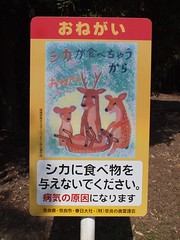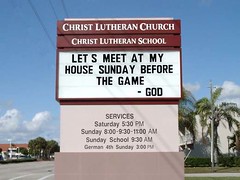This week, my reading class has been practicing inference, and I like to bring in real world images to practice on before moving to the much drier textbook. Here's an example of an image I might use:
Photo Attribution:
Original image: "Funny Church Signs"
http://farm3.static.flickr.com/2048/2404126159_6303673c95_m.jpg
by: Mel Silvers
Released under an Attribution-Non-Commercial-Share Alike License
http://creativecommons.org/licenses/by/2.0/
As you may have noticed, I have included the copyright information for the picture. In the past, I haven't done this very often mainly because I worried about how much time it would take and wasn't sure how to do it properly. However, Creative Commons makes it super simple. To give you another example of an image I might use, below is a picture taken in Nara, Japan. Even though most of my students can't speak Japanese, they can guess the meaning from the picture, and I have them write what the sign might be saying.

I don't have to include copyright information because its from the Flickr page I share with my husband.

Love the visual dictionary idea (and the church sign)! What a marvelous resource for students to use as a reference tool. Great way to engage students in the curriculum.
ReplyDelete